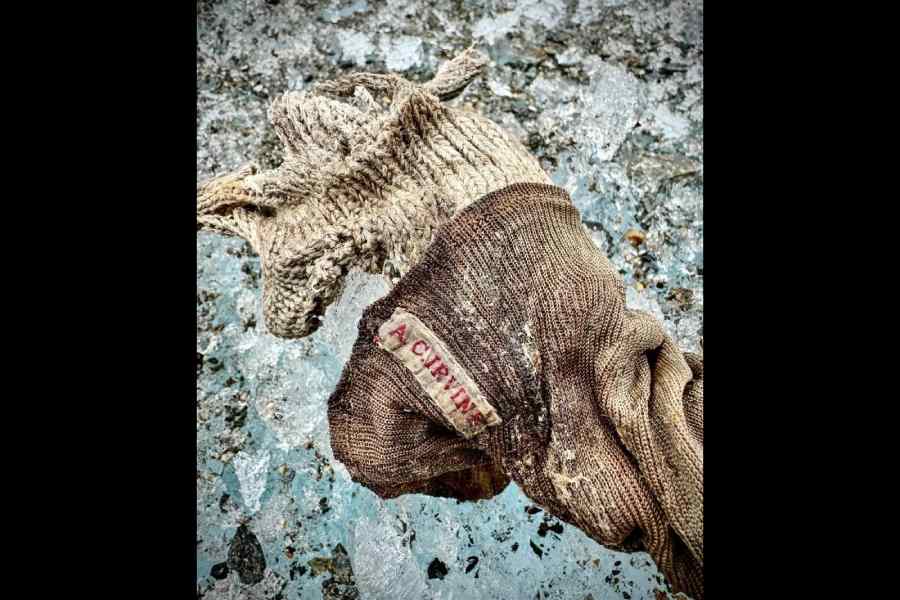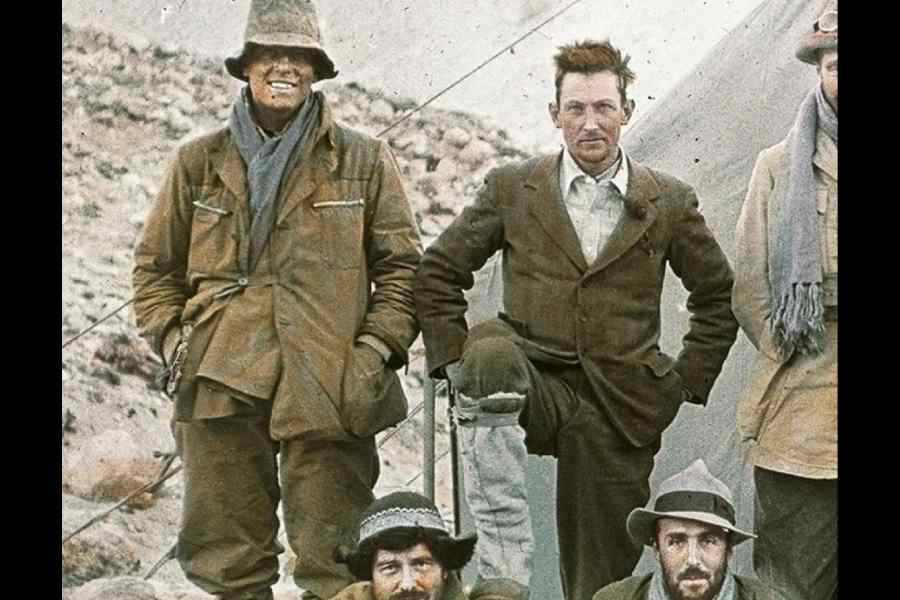A well-preserved boot found by a group of climbers on Mount Everest could be a clue to solving one of the most enduring adventure mysteries in the history of exploration of the world’s highest peak.
The climbers who made the discovery in late September have reason to believe that it could contain some of the remains of Andrew Comyn Irvine, 22, whose ascent with an expert climber in an attempt to be the first to reach the summit in 1924 led to their disappearance.
The recent explorers, from a National Geographic film crew, were on a glacier below the north face of Everest when they spotted a brown leather boot sticking out of the ice.
Looking closer, they noticed a sock with a patch sewed to it that spelled “A.C. Irvine” in stitchedred letters.
“We just kind of walked around, like for a few minutes, being like, ‘Are you kidding me?’” Jimmy Chin, a mountaineer and filmmaker, said of the find.“We just stumbled upon one of the great discoveries of our time.”

A sock with an ‘A.C Irvine’ patch was discovered on Mount Everest. It is believed to belong to Andrew Comyn Irvine. Picture by Jimmy Chin.
In April 1924, Irvine, a talented engineer but inexperienced climber from Birkenhead, England, who was better known as Sandy, joined George Mallory, a British mountaineer renowned for having reached 27,000 feet above sea level on Mount Everest in 1922.
They were aiming to become the first men to reach the very top. But they were last seen on June 8, 1924, between 800 to 1,000 feet away from the 29,032-foot summit, said Mick Conefrey, an alpinist and author of Fallen: George Mallory and the Tragic 1924 Everest Expedition.
Mallory’s body was found on the mountain in 1999. But no trace of Irvine’s body had been found, prompting debate in the climbing community about his presumed death and whether they were the first unheralded climbers to reach the top.
Last month, Chin and a team of film producers with National Geographic were shooting a documentary on the north side when they found the clue they did not know they were looking for.
As they roamed around the glacier, the group came upon a metal oxygen tank labelled with the year 1933 — the year of a British Everest expedition that followed a route similar to the 1924 journey.
“If Sandy had fallen down the north face, his remains might not be far,” Chin, a director of the acclaimed mountain-climbing film Free Solo, remembered thinking.
The group decided to continue looking around with the possibility of finding another artefact that might lead them to Irvine. Chin said that one day, as they were exploring the central Rongbuk Glacier, one of the climbers shouted, “Oh, my God! Oh my God! Ohmy God!”
Sticking out of the ice was the leather boot.
Aside from the boot’s tip, which was separated from the toe, the boot seemed to be in incredible condition. The laces were still threaded through its eyelets and the robust stitching kept the boot intact.
As the team looked further, they saw a sock coming out of the top of the boot. Sewed on to the sock was a patch spelling “A.C. Irvine.”
They did not know what to think, but they were overtaken by the rush of discovery.
“I think it was just a lot of expletives,” Chin recalled in an interview Friday night. “We weren’t particularly coherent in that moment.”
Abiding by rules put in place by the China Tibet Mountaineering Association against taking things off the mountain without explicit permission, the team members left the boot where they had found it and marked its coordinates.
When the team returned later to retrieve the boot, its position had been moved — probably by birds, Chin said — signifying that it had just recently been thawed and that there probably were human remains inside. The team brought the boot down the mountain in a cooler.
Chin said the circumstances leading to the discovery felt “oddly like fate”: The documentary team was slightly off course from where it had planned to be; the sock was labelled with the missing mountaineer’s name; and the boot had apparently only recently thawed before their arrival.
“It’s like finding a needle in 100 haystacks,” he said.
The Mountaineering Association has the boot, and the British Consulate took a DNA sample to try to verify the identity of the person who wore it.
This mystery of Irvine’s disappearance has remained relevant through the decades because of the worldwide attention that pioneering Mount Everest explorations have drawn and because of the lack of clarity about how the two men died or how far they made it.
Some questions were answered when Conrad Anker, an American rock climber, found Mallory’s body on May 1, 1999.
“Mallory’s leg was broken and his shoulder damaged, suggesting that a fall must have contributed to his death,” The New York Times reported at the time, citing “reports in climbing circles”.
Mallory, who was 37, was also still connected to “a length of climbing rope” when he was found, The Times reported. This signified that the two explorers were probably tied together and might have slipped to their deaths, Conefrey said.
Julie Summers, Irvine’s great-niece and the author of Fearless on Everest: The Quest for Sandy Irvine”, said that Irvine’s mother never spoke of him again after he died.
Irvine’s sister, who was Summers’s grandmother, “had a picture of him above her bed until the day she died.”
Summers added, “Whenever someone asked her about him, she would say, ‘He was a greater man than you all will ever be.’”
Summers accepts that not every question will be answered, such as whether the two men made it to the summit. But with the recent find, she expects to have some much-needed closure.
“This was a young man whose eyes were wide open and he was excited,” she said. “He certainly lived life to the full and didn’t waste a minute of it.”
New York Times News Service











